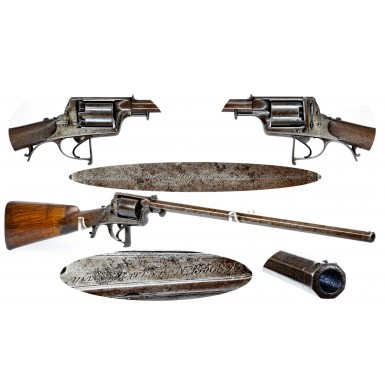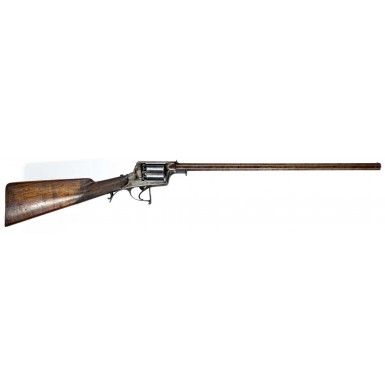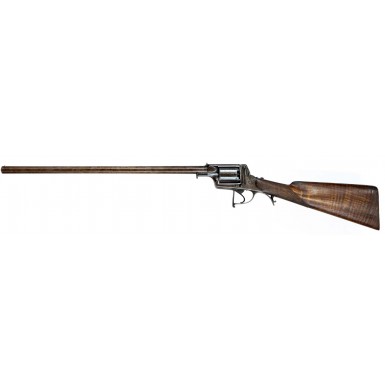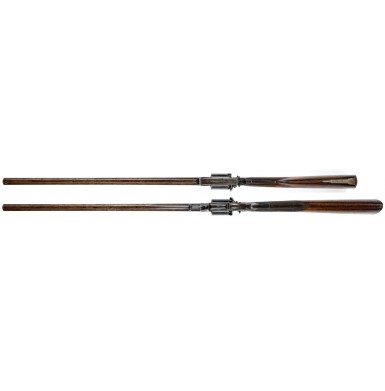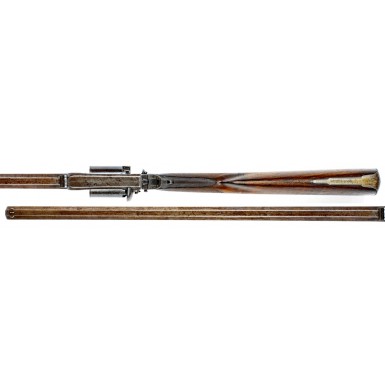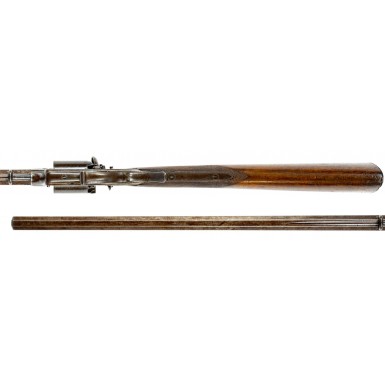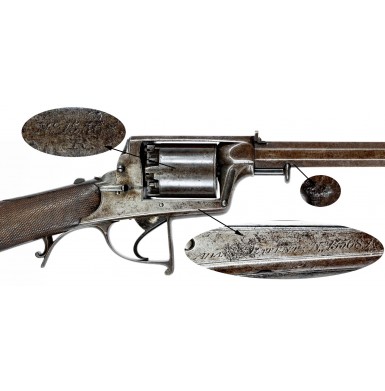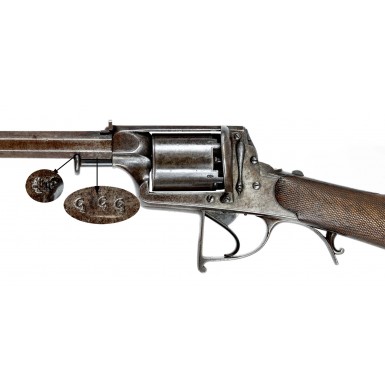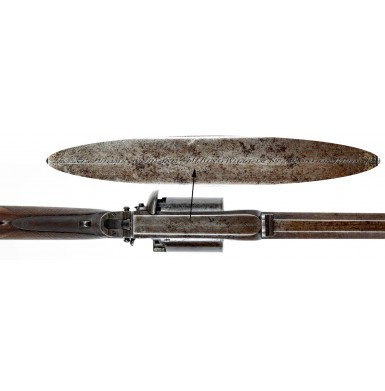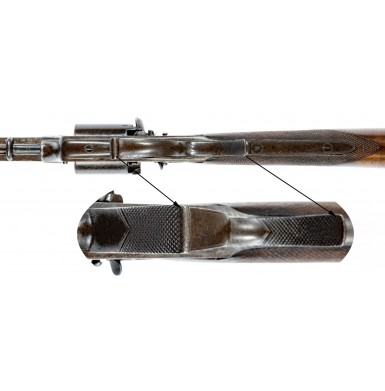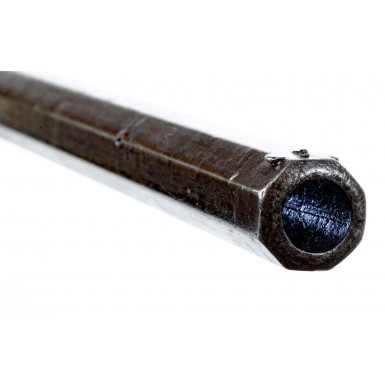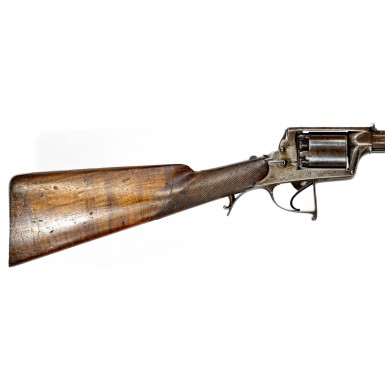Adams Patent Revolving Rifle by Deane, Adams & Deane
- Product Code: FLA-3647-SOLD
- Availability: Out Of Stock
-
$1.00
This is a very attractive example of a very scarce English Adams Model 1851 “Self-Cocking” Revolving Rifle. These fine quality, solid frame revolving rifles were a logical outgrowth of Robert Adams’ double action percussion revolver design. The arms of Robert Adams were as important to the history and development of the revolving repeating firearms as were the developments and designs of Samuel Colt. Robert Adams received his patent for a solid frame, one-piece revolver design in 1851. The patent covered his novel concept for a very strong revolver, where the frame and barrel were machined from a single steel forging. Unlike practically every other revolver design of the period, where the barrel and frame were separate components that were joined by wedges, screws or some other mechanical system. Adams additionally patented a self-cocking lockwork, which today would be referred to as “double action only”. This mechanism cocked the hammer, rotated the cylinder and released the hammer, all as the result of a single pull of the trigger. While this allowed for rapid fire, the long, heavy trigger pull inhibited accurate firing. These designs were incorporated into Adams M1851 self-cocking revolver. The major drawbacks to Adams’ M1851 design were the heavy double action only trigger and the lack of an integral loading lever, requiring loading tools to be transported with the gun if it needed to be reloaded while being carried.
In 1854 Lt. Frederick Beaumont developed an improvement for Adams’ lockwork, which produced what would be called a traditional “double action” revolver today. The new lockwork allowed the revolver to operate in the fashion of Adams’ original design (double action), but also added the facility to cock the revolver manually and fire it with a lighter “single action” trigger pull. This refinement allowed for more accurate shooting. Interestingly the development still required the trigger to rotate and index the cylinder on most versions, unlike Colt’s design, which rotated the cylinder simultaneously with the cocking of the hammer. In 1854, Adams also patented refinements to his original frame design by adding a sliding frame mounted safety on the right side of the frame and an improved cylinder arbor retaining mechanism as well. The resultant combination of design improvements was manufactured as the M1854 revolver, known to most as the Beaumont-Adams revolver.
The revolvers were produced directly by Adams as part of his partnership with the London based Deane, Adams & Deane (circa 1853-1855), as well under license by gunmakers like Joseph Brazier and Isaac Hollis & Sons. Brazier and Hollis also produced frames under Adams’ license, which they subsequently provided to Adams for his company to build revolvers. Birmingham gunmaker William Tranter also employed Adams’ solid frame in the production of his revolvers but utilized lock works of his own design. Upon the dissolution of the Deane, Adams & Deane firm, Adams went to work for the London Armoury Company, and his revolvers were produced there as well; both while he worked there from 1857-1858 and well into the production of the London Armoury made Kerr revolvers, circa 1860.
Upon leaving the London Armoury Company, Adams went back to work producing his own revolvers, many of which were retailed by other London and Birmingham gun dealers and were often marked with the retailer’s name on the top strap. While most of the Beaumont-Adams revolvers were produced with loading levers designed by Adams, Joseph Rigby, or those patented by James Kerr (especially the guns manufactured by the London Armoury Company), a few were manufactured with a rather complex loading lever designed by Joseph Brazier. Joseph Brazier was a very successful gun, rifle & pistol maker in Wolverhampton, Staffordshire. He was most famous for producing extremely high-quality gunlocks and many of the top target rifle manufacturers utilized Brazier locks in their rifles. Brazier established his business in 1827, and in 1849, the firm became Joseph Brazier & Sons. That firm remained in business under varying versions of the Brazier name until 1987. The greater part of the firm’s 19th century manufacturing took place at their works known as “The Ashes” on Great Brickklin Street, from 1834-1880. In 1855, Brazier received British patent #760 for a loading lever for percussion revolvers. Brazier applied this lever to the Adams revolvers that he manufactured under license and offered them for sale to other gun makers who wanted to include the loading lever on the pistols they made or sold. All his levers were numbered, and to the best of my knowledge, the highest number encountered is around 900. Thus, these loading levers are relatively rarely encountered on Adams revolvers.
Many of the Beaumont-Adams revolvers encountered today are double “serial numbered”, with one “serial number” actually being the number that tracked the royalty payments due to Adams on his solid frame patent. These numbers are typically marked with a suffix letter that indicates the manufacturer using the patent (for example “T” for Tranter, “B” for Brazier and “X” for Hollis & Sons). Those pistols produced by Adams himself are usually suffixed with an “R” or with no letter at all. The second number has a “B” prefix to track the royalty payments due to Beaumont on his lock work patent. However, after the expiration of both patents, the guns are normally marked with only a single serial number and without any prefix or suffix letter. The Beaumont patent expired in early 1862, so these single serial number guns were most likely assembly after the expiration of his patent. As Adams allocated serial number ranges to licensees who had the right to manufacture guns on his solid frame principle, it can be quite difficult to date Adams revolvers by serial number, especially prior to the expiration of the Beaumont patent. According to English revolver authors & researchers W.H.J. Chamberlain and A.W.F. Taylerson, Brazier was allocated some numbers in the 30,000 B range prior to 1854, with the “B” suffix, while Adams himself produced revolvers in the same serial number range with an “R” suffix. They note that Hollis & Sheath never had their own serial number range but used their “X” suffix to distinguish their work, and that Adams often relied upon frames manufactured by William Tranter to manufacture his own revolvers! All of this clearly muddles the serial number picture for Adams handguns from about 1854-1860. From extant examples, however, it does appear that sometime in the mid-30,000 range serial numbers do become somewhat more consistent, and some inferences regarding dates of manufacture, attributed use, etc. can be drawn from the serial numbers of extant examples.
As early as 1851, Adams introduced a revolving rifle variant of his handgun, which was a logical extension of the design. Colt pursued the revolving rifle concept very early in his career as well, with a variety of rifles, carbines and shotguns being produced along his with his Paterson revolving handguns. Theoretically, Adams introduced the long arms in hopes that the board of Ordnance Small Arms Committee might consider the design for adoption in military service. Colt had experienced moderate success with his Paterson longarms being acquired by the US military, with a small number purchased by both the Navy and the Army for trial purposes.
The Adams rifles were typically chambered between 38 bore (.50 caliber) and 25 bore (.577 caliber) and shotgun variants were produced as well. While never anywhere near as successful as his handguns, the rifles offered the customer an opportunity to acquire a repeating long arm that Adams’ own promotion literature cited as being useful out to 200 or 300 yards. Like the handguns, the rifles used 5-shot percussion cylinders and evolved along a similar path as the revolvers. The rifles appear to have been numbered in the same serial number range as the handguns, allowing some rough dating of their manufacture based upon the number. The rifles included a removable brass hammer shroud that covered the spurless hammer. This reduced the potential for cap flash burning the face of the shooter and protected the eyes in the case of a split cap being ejected from the rear of the percussion cone. The rifles incorporated a leaf rear sight, with a fixed blade set nominally for 50-yards and with one or two leaves for longer ranges. As any percussion revolving firearm had the potential for chain firing of the cylinder, it was considered unsafe to hold the rifle forward of the cylinder when firing. For this reason, the triggerguard included an extended flat front face to provide a place for the off-hand to hold the gun. Despite the evolution of the revolving rifles as improvements were made to the handguns, the M1854 Beaumont-Adams lock work with the hammer spur never appears to have been incorporated into the revolving rifle design.
The Beaumont-Adams revolvers, in their .54-Bore configuration (about .442 caliber), were one of the best combat revolvers of the mid-19th century and as such a number of them were imported for use during the American Civil War. However, the lack of records makes it is difficult to ascertain exactly how many Adams patent revolvers were imported for use during the American Civil War. At least 1,075 were purchased directly by the US government. It is known that some military outfitters like Schuyler, Hartley & Graham purchased quantities of these revolvers for private sale to officers and those volunteer groups who looked to their state and local government (rather than the US government) to purchase arms. Some of the Schuyler, Hartley & Graham guns (about 300) are reported to have been purchased by the state of Alabama prior to the start of the war. Virginia and Georgia are reported to have made pre-war purchases of these revolvers as well. While the Confederate central government never directly contracted to purchase Adams patent revolvers, they concentrated on purchasing Kerr’s Patent revolvers from the London Armoury Company, Confederate speculators and individual states did purchase these fine English revolvers in some quantity. In fact, many Adams revolvers, manufactured by the London Armoury Company, are believed to have been in the L.A.C. inventories at the outbreak of the war. It seems quite probable that when Major Anderson and Commander Bulloch initiated their relationship with Archibald Hamilton of Sinclair, Hamilton & Co, who was also the managing director of the London Armoury Company, they arranged for a substantial number of these revolvers to be delivered to various Confederate states and to the Confederate Navy. Several Confederate identified and presented Beaumont Adams revolvers exist in public and private collections, including #40537 in the American Civil War Museum (formerly the Museum of the Confederacy). This revolver is cased with an engraved presentation plaque from Robert Adams to Confederate General Stonewall Jackson. Two other Adams revolvers in the low 41,XXX range are attributed to Confederate naval use aboard the CSS Shenandoah. Most Confederate war time purchases are believed to have fallen within the 33,000 to 42,000 serial number range, although it is quite likely that guns produced prior to that range (and imported to America) were used, and in some cases old stock, sitting on the shelves of London and Birmingham retailers, was sold to Confederate speculators. This resulted in some pistols that were several years old, but were actually “new old stock” passing through the blockade.
Civil War regiments that are known to have carried or been issued Adams Patent revolvers include the 8th PA and 2nd MI cavalry on the US side and the 1st, 5th & 18th VA and 5th GA cavalry on the CS side. Two Beaumont-Adams are specifically listed by serial number on the Pratt List, a list of the revolvers (by make & serial) in the possession of the cavalry squad of Lt. G. Julian Pratt, who served in Company H of the 18th VA Cavalry. The guns are #36604, carried by trooper James Tharp and #36609 carried by George Conrad. The squad roll is from July of 1864, and lists not only Adams, but also Kerr, Webley and Bentley revolvers. This primary source document is often used as a time point to determine when certain English revolver serial numbers can be determined to have been in field service for the Confederacy. The list is often used as an indication that Kerr’s in the 9XXX range were in service at that point in time. In the case of the Adams revolvers, it shows they were in field service, but the serial numbers are from guns produced much earlier than 1864. A Confederate identified Beaumont-Adams; serial number 36853 is in a private collection, with a New Orleans retailers mark on the topstrap. Realistically, this places any Beaumont-Adams under that number as having been produced prior to the fall of New Orleans in April of 1862. It is generally assumed that the majority of the Adams pattern revolvers in Confederate service were 54-Bore bore (about .442 caliber), but a handful of 38-Bore (.50 caliber) of the earlier M-1851 pattern have Confederate provenance as well.
While no Confederate central government purchases of English revolving rifles can be documented, at least one case of speculative purchases by southern buyers can be. On October 31, 1861 the blockade runner Salvor was captured in the Gulf of Mexico, making for Tampa Bay. Listed in the appraisal of the cargo of the ship were four English revolving rifles. One was listed as being in a mahogany case and was valued at $35 and three were not cased, valued at $25 each. Although the make of the rifles was not noted, they were likely Adams, or possibly Tranter revolving rifles. If one ship was bringing in a few English revolving rifles this early in the war, it seems quite plausible that other speculative purchases of revolving rifles were successfully delivered to the Southern Confederacy during the course of the war, which we have no record of. At least one example of an Adams revolving rifle in the collection of the South Carolina Historical Society in Charleston has provenance to having seen use during the Civil War with a local Confederate solider.
Offered here is a rare Model 1851 Adams Revolving Rifle in VERY GOOD+ condition. The rifle is 38-bore, nominally .50 caliber and has a 5-shot percussion cylinder. The rifle has a 23 ¼” long octagonal barrel and has an overall length of 40 ¾”. The double action only, “self-cocking” revolving rifle has a length of pull of 14 ¾”. The obverse frame is engraved in a single line below the cylinder: ADAMS’ PATENT, No. 15,568 R. The “R” suffix indicates that Robert Adams, as part of Deane, Adams & Deane, was the maker of the gun. The top strap is engraved in a single line: DEANE ADAMS & DEANE . 30 . KING WILLIAM STT LONDON BRIDGE. The cylinder bears the matching serial number and is engraved in two lines: No 15,568 / R. The cylinder has the expected London commercial proof marks between the chambers, a {CROWN} / V and a {CROWN} / GP. The barrel has a London commercial view mark, a {CROWN} / V on the lower right angled flat, as well as the expected {CROWN} / GP proof mark on the lower left angled flat. The assembly number 555 is also stamped in this location with the matching assembly number stamped on the rear face of the cylinder. It is difficult to date Adams revolvers from their serial numbers the way you can with Colt revolvers. However, it is reasonable to assume the revolver was produced circa 1854-55 by Adams, prior to joining the London Armoury Company.
The revolver in unadorned other than some simple boarder line engraving around the edges of the frame and buttplate and checkering at the wrist of the straight-gripped stock. The octagonal barrel is 23 ¼” in length and is rifled with three wide, shallow grooves. The bore rates about GOOD+ to NEAR VERY GOOD. It has a mottled and oxidized appearance with strong visible rifling and evenly distributed light pitting along its length as well as some patches of more moderate pitting. As previously noted, the gun is in about VERY GOOD overall condition. The barrel retains some strong, streaky traces of the original browned finish, which has thinned and worn and mixed with an oxidized brownish-gray patina. The barrel is mostly smooth with some scattered patches of oxidized surface roughness and some lightly scattered areas of minor pitting here and there. The frame retains no finish and has a similarly oxidized brownish-gray patina as the barrel. The frame shows slightly more light pitting, particularly around face of the cylinder and along the upper and lower edges of the frame. The cylinder matches the patina of the frame and barrel and retains no finish either. The cylinder shows scattered surface oxidation and discoloration, along with some scattered pinpricking and some very lightly scattered pitting. There is also some minor pitting and moderately oxidized roughness in the recesses where the cones (nipples) are, typical of the wear caused by caustic percussion caps. The cylinder retains all of its original cones and all are in very good, relatively crisp condition. The triggerguard has the expected long, flat front face with a checkered surface and terminates at the rear of the guard with a skeletonized semi-pistol grip, with that spur checkered as well. The rifles shows both M1851 and M1854 patent features in the action. The lock work is pure M1851 double-action only and the retains its original M1851 patent spring safety on the reverse of the frame, which functions smoothly and correctly. By barely pulling the trigger the safety can be pressed into the frame, engaging the hammer and creating a hammer block that also frees the cylinder to rotate for loading and unloading. The system is nearly identical to that found on the French Perrin revolver. Pulling the trigger automatically disengages the safety, allowing the gun to fire once the trigger is pulled fully to the rear. The Adams M1851 patent spring arbor pin retention mechanism is in place on the right side of the frame, forward of the cylinder and functions exactly as it should. The rifle also incorporates Adams’ M1854 patent sliding safety on the right side of the frame. This safety engages the rear of the cylinder, locking it and preventing rotation. This safety is complete and fully functional, operating exactly as it should. The action of the revolver is mechanically EXCELLENT, and the gun times, indexes and locks up exactly as it should. The removable brass hammer shroud is missing from the rifle, which is typical. Finding an Adams revolving rifle with the original hammer shroud is the exception, not the rule. As with most of the Adams long arms, this M1851 pattern rifle was produced without an attached loading lever, as were the M1851 revolvers. The rifle retains its original rear sight, with the fixed leaf in place, bu the folding longer-range leaf missing. The original front sight is present as well, with the dovetailed blade showing some wear. The straight-gripped walnut butt is in about VERY GOOD+ condition. The wrist is nicely checkered, and the checking remains fairly crisp with only some light wear. The butt is solid with no breaks or repairs noted. The wood does show a couple of tight surface grain cracks, but these are quite minor and non-structural. The butt has nice grain and appears to have been oil finished. The stock shows scattered bumps, dings and surface mars, as well as some minor flattening to the points of the checkering.
Overall, this is a very nice example of a scarce Adams Revolving Rifle. The gun is 100% original and is complete with the exception of the missing hammer shroud and one of the sight leaves. These revolving rifles rarely appear for sale in such nice, solid condition and this would be a fantastic addition to any collection of revolving rifles or Adams revolving firearms. The rifle displays very well, is fully functional and is a gun that I am sure you will be glad to add to your collection.
SOLD
Tags: Adams, Patent, Revolving, Rifle, by, Deane, Adams, &, Deane

